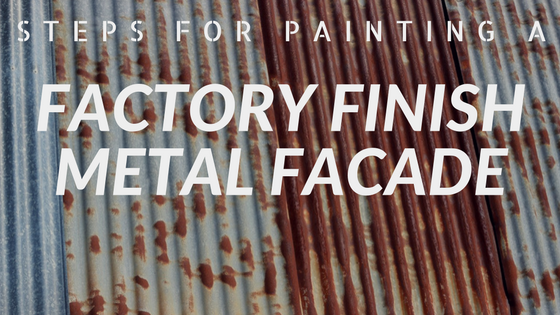
Providing adequate protection against different environmental factors and improving the curb appeal of your commercial or industrial facility are two reasons why you should consider painting your factory finish metal facade.
As we have plenty of experience preparing and coating different metal surfaces in outdoor environments, this blog post outlines the steps a painting contractor should take when painting metal components pre-treated in factory-controlled environments.
Step #1: Choosing adequate surface preparation methods.
Pressure washing factory finish metal facades with plain water is often sufficient to remove dust, dirt, and chalk, and also ensure good adhesion between the substrate and the new coat of paint. Painting the metal facade as soon as it dries completely will prevent dust and dirt from accumulating on it again.
If existing coatings have failed prematurely, painting contractors can use additional surface preparation techniques, such as dry and wet blasting, in order to eliminate rust, corrosion, dents, and other defects. Because these two surface preparation methods can create a new surface profile, they can be used to restore metal surfaces to their original condition and ensure optimum coating adhesion. Depending on the type and extent of the damage, power or hand sanding might also be necessary in order to achieve the best results.
Step #2: Specifying coating products.
Because factory finish metal facades are already pre-treated with a corrosion-inhibiting base coat, industrial painters only need to select intermediate and top coats, based on the man-made and natural environmental factors the metal facades will be exposed to.
In hot and humid climates, for instance, metal facades should be coated with products that can withstand strong UV radiation, high humidity levels, rain, hail, and any other potential weather events. As metal facades tend to get very hot when they are exposed to solar radiation, opting for reflective coating systems, which are similar to the products used for cool roofs, is a good strategy to protect your facade from early degradation and lower your energy bills by keeping your building cooler.
In industrial settings, painting contractors should also take into account any hazardous substances, dust, fumes, and smog that may result from work processes. If certain operations are expected to release acid residues, for example, choosing a coating system with chemical and corrosion resistance properties is key to a durable paint job.
Step #3: Selecting the right coating application techniques.
When coating factory finish metal facades, paint products can be applied by:
- Air spraying – Conventional air spraying uses low pressure compressed air to atomize paints. This method is suitable for projects that require paint application in thin layers.
- Airless spraying – In airless spraying, paint pressure is achieved with the help of a piston or membrane pump instead of compressed air. Because coatings can be applied in thicker coats, the film thickness required can be achieved with fewer coats compared to air spraying.
- Rolling – Protective coatings can also be applied by rollers. However, coating products must be specifically formulated for roller application in order to achieve a high-quality finish.
- Brushing – Brush application is often recommended for maintenance activities, touch-up work, difficult-to-reach areas, and small paint tasks where spray painting is impractical.
Performance Painting Contractors specializes in coating applications and maintenance for industrial and commercial facilities. For the latest surface preparation methods, modern coating technologies, reliable inspection and preventative maintenance programs, please contact us today.






